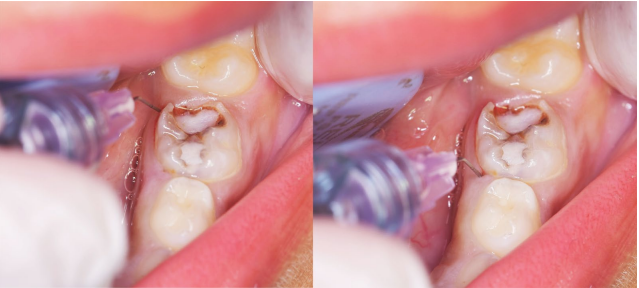An interesting article titled “Computer-controlled Intraligamentary local anaesthesia in extraction of mandibular primary molars: randomised controlled clinical trial,” appears in the 2022 edition of BMC Oral Health written by Rodaina H. Helmy and et. al. (vol 22, no. 194, pp. 1-10). The article seeks to explore the pain experience when using a computer controlled anethesia injection while extracting lower primary molars in children.
To explore the pain experiences of children, 50 healthy children between the ages of 5 and 7, with 29 females, and 21 males, who needed a lower primary molar extractioned were included in the trial. The parents of the children had to consent to inclusion in the trial. Any child who had teeth that showed signs of mobility, acute pathosis, ankylosis, or root resorption affecting more than a third of the root were excluded from the study. Each child had an introductory visit with the dentist that did not include any treatment. Half of the children were given computer-controlled intraligamentary anaesthesia (CC-ILA) and the other half of the children in the study were given a traditional inferior alveolar nerve block (IANB). Intraligamentary anaesthesia is an intra osseous injection with local anesthesia reaching the cancellous space in the bone via the periodontal ligament. Intraligamentary anesthesia is believed to prevent soft tissue injury but only lasts for around 20 minutes in duration.

Each child had the extraction performed using lower full crown forceps. During the extraction pain was measured by three parameters. The first measure of pain included a pulse oximeter placed on the child’s index finger at three diffent time points to measure heart rate. The second measure of pain included a modifed face pain scale. Each child was asked to select the face that represented their experience right after injection and extraction. The third measure of pain included analysing video recordings using a sound-eye-motor scale. Sounds, eye and body movements from each child were graded from 1 to 4 during needle injection and extraction.
The authors found that during injection of the anesthesia, the heart rate of the children given the computer controlled anesthesia was statisically signficantly lower than that of the children given the standard nerve block. The mean heart rate measurements during injection was 104.64 and 113.48 in the computer controlled anesthesia group and standard nerve block group respectively. In the computer controlled anesthesia group 22 children said they were satisfied after injection while only 14 were satisified after injection in the standard nerve block group. Further, in the computer controlled anesthesia group 21 children said they were satisfied after extraction while only 13 were satisified after extraction in the standard nerve block group. The mean sound-eye-motor scale score was found to be 1.15 during injection for the computer controlled anesthesia group and 2.53 during injection for the standard nerve block group. The mean sound-eye-motor scale score was found to be 1.76 during extraction for the computer controlled anesthesia group and 2.53 during extraction for the standard nerve block group. The study also mentioned that 24 hours after the extractions parents of children in the alveolar nerve block group reported 32% of their children experienced lip biting while no parents of the children in the computer controlled anesthesia group reported any lip biting after the extraction.
The authors state:
“The CC-ILA afects only a single tooth without anaesthetizing the perioral tissues, which eliminates any cheek/lip biting events in comparison to IANB, which afects a very wide area other than target teeth, so children encounter total or partial loss of sensitivity of the lip and cheeks for the whole duration which may last for hours.”
From the study conducted, the authors feel that computer controlled anesthesia allows for injections that cause less pain and eliminates the side effect of lip biting events when compared to inferior alveolar nerve block.
The authors note several limitations of the study which include that anxiety often precedes dental procedures such as extractions and injections, which may have acted as a confounding factor and potentially have negatively impacted the pain reaction measured. The authors also suggest that additional reseach using computer controlled anesthesia for dental procedures that take longer time durations than the 20 minutes in the study are needed before it should be considered for regular use in pediatric dentistry.
